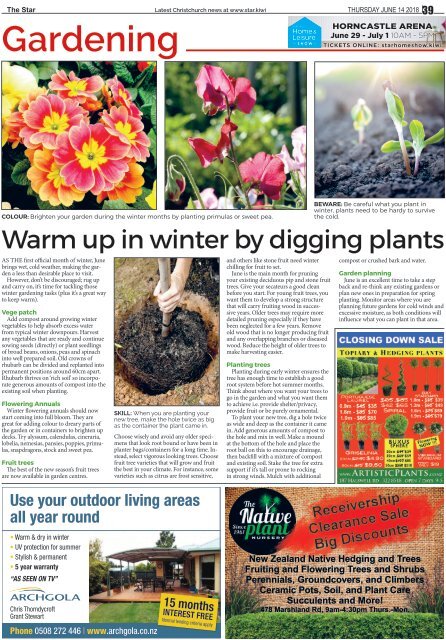The Star: June 14, 2018
Create successful ePaper yourself
Turn your PDF publications into a flip-book with our unique Google optimized e-Paper software.
<strong>The</strong> <strong>Star</strong> Latest Christchurch news at www.star.kiwi<br />
Thursday <strong>June</strong> <strong>14</strong> <strong>2018</strong> 39<br />
Gardening<br />
HORNCASTLE ARENA<br />
<strong>June</strong> 29 - July 1 10AM - 5PM<br />
TICKETS ONLINE: starhomeshow.kiwi<br />
COLOUR: Brighten your garden during the winter months by planting primulas or sweet pea.<br />
BEWARE: Be careful what you plant in<br />
winter, plants need to be hardy to survive<br />
the cold.<br />
Warm up in winter by digging plants<br />
AS THE first official month of winter, <strong>June</strong><br />
brings wet, cold weather, making the garden<br />
a less than desirable place to visit.<br />
However, don’t be discouraged; rug up<br />
and carry on, it’s time for tackling those<br />
winter gardening tasks (plus it’s a great way<br />
to keep warm).<br />
Vege patch<br />
Add compost around growing winter<br />
vegetables to help absorb excess water<br />
from typical winter downpours. Harvest<br />
any vegetables that are ready and continue<br />
sowing seeds (directly) or plant seedlings<br />
of broad beans, onions, peas and spinach<br />
into well prepared soil. Old crowns of<br />
rhubarb can be divided and replanted into<br />
permanent positions around 60cm apart.<br />
Rhubarb thrives on ‘rich soil’ so incorporate<br />
generous amounts of compost into the<br />
existing soil when planting.<br />
Flowering Annuals<br />
Winter flowering annuals should now<br />
start coming into full bloom. <strong>The</strong>y are<br />
great for adding colour to dreary parts of<br />
the garden or in containers to brighten up<br />
decks. Try alyssum, calendulas, cineraria,<br />
lobelia, nemesias, pansies, poppies, primulas,<br />
snapdragons, stock and sweet pea.<br />
Fruit trees<br />
<strong>The</strong> best of the new season’s fruit trees<br />
are now available in garden centres.<br />
SKILL: When you are planting your<br />
new tree, make the hole twice as big<br />
as the container the plant came in.<br />
Choose wisely and avoid any older specimens<br />
that look root bound or have been in<br />
planter bags/containers for a long time. Instead,<br />
select vigorous looking trees. Choose<br />
fruit tree varieties that will grow and fruit<br />
the best in your climate. For instance, some<br />
varieties such as citrus are frost sensitive,<br />
and others like stone fruit need winter<br />
chilling for fruit to set.<br />
<strong>June</strong> is the main month for pruning<br />
your existing deciduous pip and stone fruit<br />
trees. Give your secateurs a good clean<br />
before you start. For young fruit trees, you<br />
want them to develop a strong structure<br />
that will carry fruiting wood in successive<br />
years. Older trees may require more<br />
detailed pruning especially if they have<br />
been neglected for a few years. Remove<br />
old wood that is no longer producing fruit<br />
and any overlapping branches or diseased<br />
wood. Reduce the height of older trees to<br />
make harvesting easier.<br />
Planting trees<br />
Planting during early winter ensures the<br />
tree has enough time to establish a good<br />
root system before hot summer months.<br />
Think about where you want your trees to<br />
go in the garden and what you want them<br />
to achieve i.e. provide shelter/privacy,<br />
provide fruit or be purely ornamental.<br />
To plant your new tree, dig a hole twice<br />
as wide and deep as the container it came<br />
in. Add generous amounts of compost to<br />
the hole and mix in well. Make a mound<br />
at the bottom of the hole and place the<br />
root ball on this to encourage drainage,<br />
then backfill with a mixture of compost<br />
and existing soil. Stake the tree for extra<br />
support if it’s tall or prone to rocking<br />
in strong winds. Mulch with additional<br />
compost or crushed bark and water.<br />
Garden planning<br />
<strong>June</strong> is an excellent time to take a step<br />
back and re-think any existing gardens or<br />
plan new ones in preparation for spring<br />
planting. Monitor areas where you are<br />
planning future gardens for cold winds and<br />
excessive moisture, as both conditions will<br />
influence what you can plant in that area.<br />
Use your outdoor living areas<br />
all year round<br />
• Warm & dry in winter<br />
• UV protection for summer<br />
• Stylish & permanent<br />
• 5 year warranty<br />
“AS SEEN ON TV”<br />
Chris Thorndycroft<br />
Grant Stewart<br />
Phone 0508 272 446 | www.archgola.co.nz<br />
15 months<br />
INTEREST FREE<br />
Normal lending criteria apply<br />
New Zealand Native Hedging and Trees<br />
Fruiting and Flowering Trees and Shrubs<br />
Perennials, Groundcovers, and Climbers<br />
Ceramic Pots, Soil, and Plant Care<br />
Succulents and More!<br />
478 Marshland Rd, 9am-4:30pm Thurs.-Mon.


















